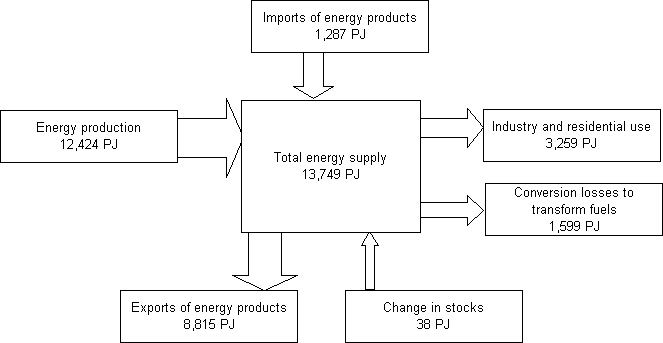Energy is a vital input to all sectors of the economy. As well as supplying the power on which industry and households depend, the production and supply of energy provide employment and investment opportunities, and energy is a major source of export earnings, all of which contribute substantially to the welfare and standard of living of Australians.
Australia has an abundance of fossil fuel and mineral energy resources, and our trends of energy production and use are a reflection of this abundance. In addition to being one of the world's largest exporters of coal, Australia's per capita energy consumption is one of the highest in the world, with a heavy reliance on fossil fuels. This reliance is also a major source of human-generated greenhouse gases. There is widespread national and international concern that these have caused temperatures to increase worldwide. Environment looked at atmosphere and climate change in a broad context, and provided an analysis of Australia's production of greenhouse gases from all sources (including sinks). Of these sources, the combustion of fossil fuels is responsible for about three-quarters of man-made emissions of carbon dioxide (the main greenhouse gas). These emissions associated with energy production and use are addressed in the section Greenhouse gas emissions.
The fuels produced in Australia are either consumed here, stockpiled for future consumption or export, or exported to other countries. In some cases, consumption takes place in Australia to produce another kind of fuel for consumption or export. In the case of electricity generation from fossil fuels (mainly coal), a large amount of energy is lost in this conversion process. Some fuels are imported into Australia, mainly crude oil. Diagram 15.1 illustrates the quantities of energy used for each of these purposes in 1998-99.
Over two-thirds of energy production in Australia is exported, and the mix of fuels in production and consumption are distinctly different. Black coal and uranium are expected to continue to dominate the pattern of both energy production and trade. Final consumption of energy by industry and households (excluding conversion losses) amounted to 3,259 petajoules (PJ) in 1998-99, about a quarter of the energy produced in Australia in that year.
The following sections describe Australia's energy resources, the production of these resources, and Australia's trade in energy products. Then follows an analysis of Australian energy consumption, together with a section comparing various aspects of Australia's consumption with that in a number of other Organisation for Economic Co-operation and Development (OECD) countries. The final section, Energy and the environment, includes an analysis of the impact, on those emissions, of household consumption and the production of goods and services for export.
15.1 ENERGY MODEL- 1998-99

Source: ABARE, electronic datasets.
 Print Page
Print Page